Business Environment Analysis: General Motors and Structures Report
VerifiedAdded on 2021/01/02
|13
|3761
|478
Report
AI Summary
This report examines the business environment of General Motors (GM), a UK-based multinational automobile manufacturer. It delves into different types of organizational structures, including public, private (GM), and voluntary sectors (Oxfam), analyzing their purposes, sizes, and scopes. The report explores the relationship between various organizational structures, such as marketing, finance, human resources, and production, and how these interrelate to achieve business objectives. It further links organizational structures, sizes, and scopes to business objectives, highlighting how factors like employee numbers, geographical presence, and non-profit motives influence performance. The analysis covers legal structures within each sector and evaluates how internal and external factors impact overall company performance, using PESTLE analysis to assess positive and negative influences. The report concludes by summarizing the key findings and their implications for GM's operations.
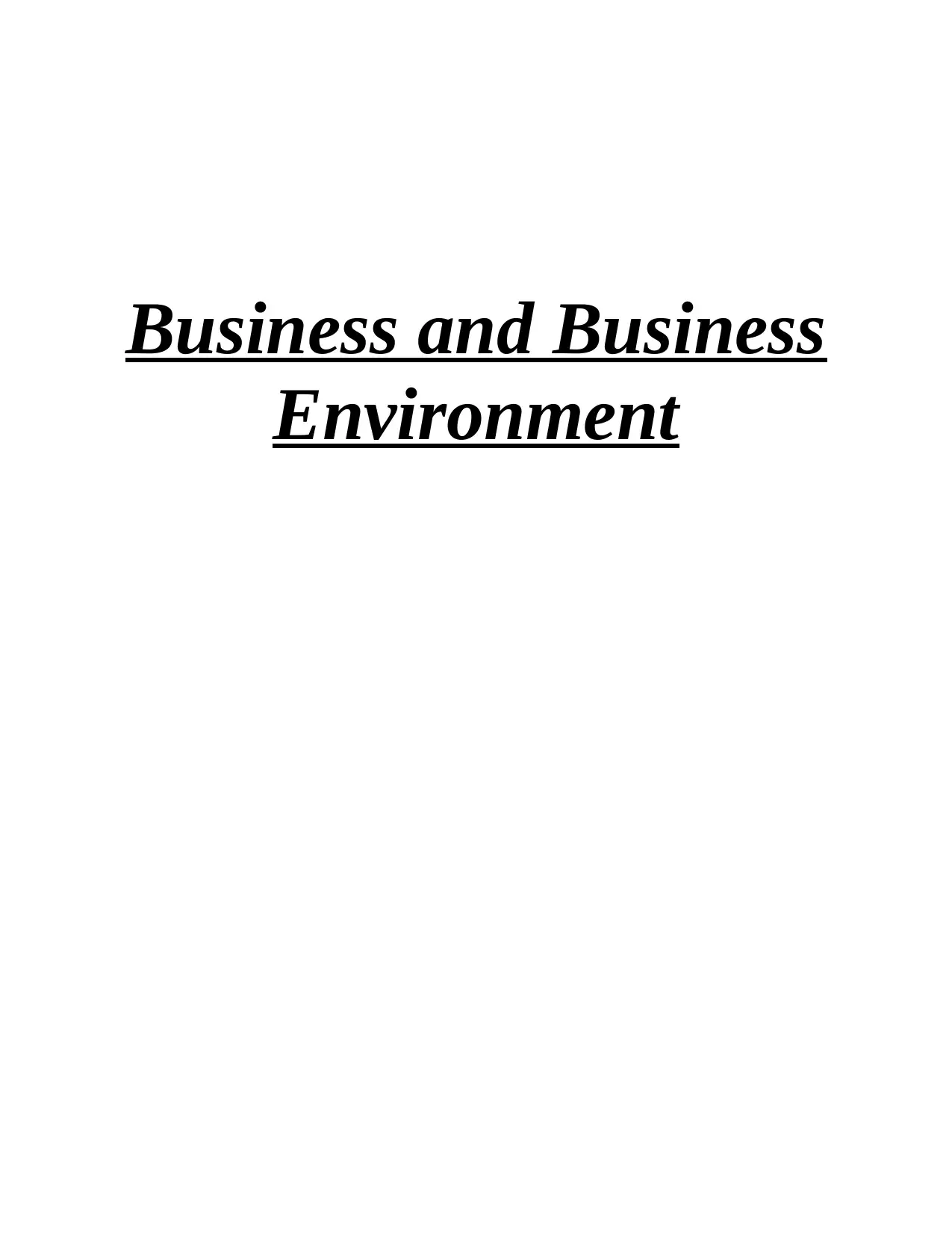
Business and Business
Environment
Environment
Paraphrase This Document
Need a fresh take? Get an instant paraphrase of this document with our AI Paraphraser

Table of Contents
INTRODUCTION...........................................................................................................................3
TASK 1............................................................................................................................................3
1 Different types and purpose of organisation.......................................................................3
2 Size & Scope of different types of organisation..................................................................4
3 Relationship between different organisational structures....................................................7
4 Analysation of structure, size, scope of different organisation linked to other business
objectives................................................................................................................................8
5 Critical analysis of different types of business structures and inter-relation of different
organisational function...........................................................................................................9
TASK 2..........................................................................................................................................11
Covered in PPT.....................................................................................................................11
CONCLUSION..............................................................................................................................11
References......................................................................................................................................12
INTRODUCTION...........................................................................................................................3
TASK 1............................................................................................................................................3
1 Different types and purpose of organisation.......................................................................3
2 Size & Scope of different types of organisation..................................................................4
3 Relationship between different organisational structures....................................................7
4 Analysation of structure, size, scope of different organisation linked to other business
objectives................................................................................................................................8
5 Critical analysis of different types of business structures and inter-relation of different
organisational function...........................................................................................................9
TASK 2..........................................................................................................................................11
Covered in PPT.....................................................................................................................11
CONCLUSION..............................................................................................................................11
References......................................................................................................................................12
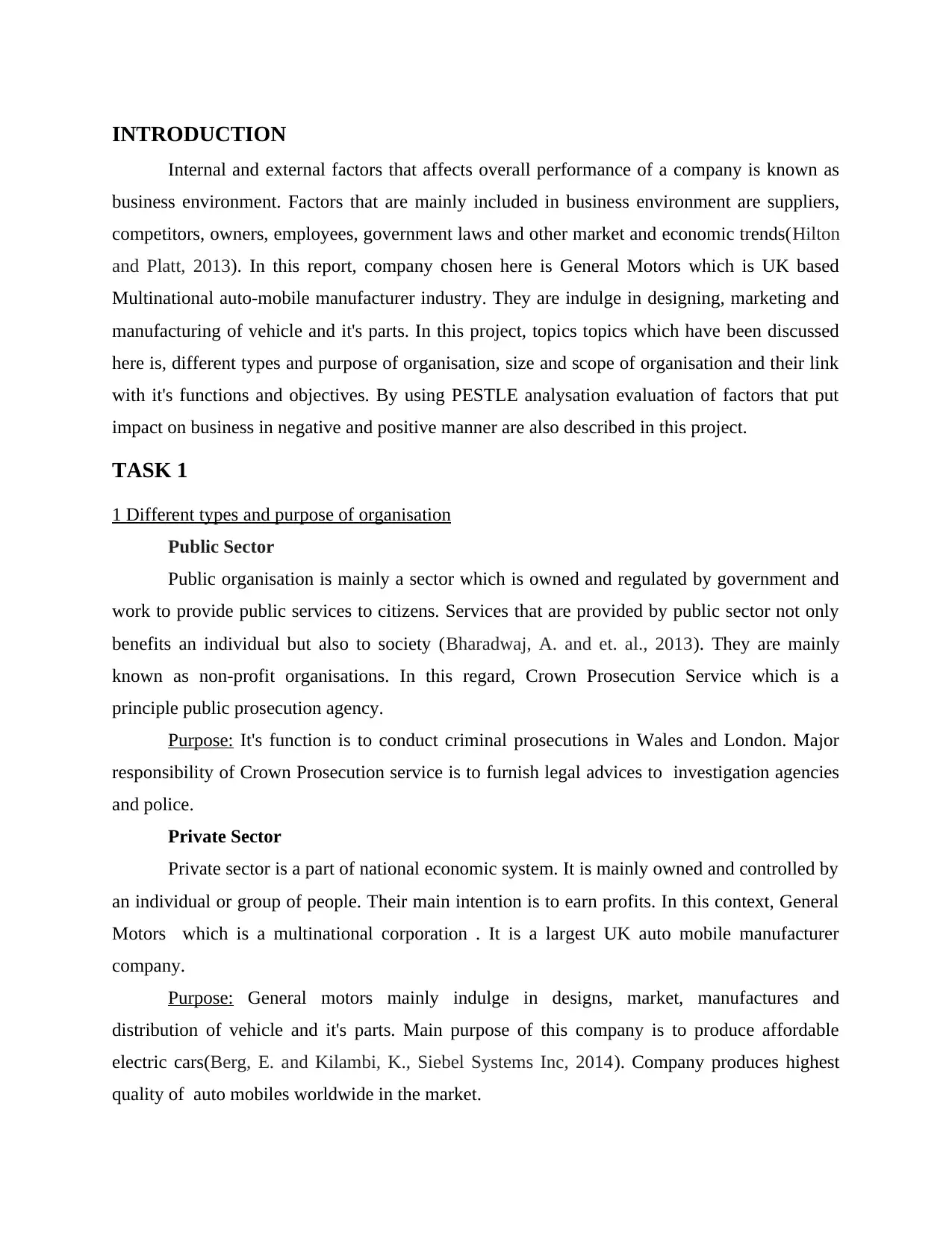
INTRODUCTION
Internal and external factors that affects overall performance of a company is known as
business environment. Factors that are mainly included in business environment are suppliers,
competitors, owners, employees, government laws and other market and economic trends(Hilton
and Platt, 2013). In this report, company chosen here is General Motors which is UK based
Multinational auto-mobile manufacturer industry. They are indulge in designing, marketing and
manufacturing of vehicle and it's parts. In this project, topics topics which have been discussed
here is, different types and purpose of organisation, size and scope of organisation and their link
with it's functions and objectives. By using PESTLE analysation evaluation of factors that put
impact on business in negative and positive manner are also described in this project.
TASK 1
1 Different types and purpose of organisation
Public Sector
Public organisation is mainly a sector which is owned and regulated by government and
work to provide public services to citizens. Services that are provided by public sector not only
benefits an individual but also to society (Bharadwaj, A. and et. al., 2013). They are mainly
known as non-profit organisations. In this regard, Crown Prosecution Service which is a
principle public prosecution agency.
Purpose: It's function is to conduct criminal prosecutions in Wales and London. Major
responsibility of Crown Prosecution service is to furnish legal advices to investigation agencies
and police.
Private Sector
Private sector is a part of national economic system. It is mainly owned and controlled by
an individual or group of people. Their main intention is to earn profits. In this context, General
Motors which is a multinational corporation . It is a largest UK auto mobile manufacturer
company.
Purpose: General motors mainly indulge in designs, market, manufactures and
distribution of vehicle and it's parts. Main purpose of this company is to produce affordable
electric cars(Berg, E. and Kilambi, K., Siebel Systems Inc, 2014). Company produces highest
quality of auto mobiles worldwide in the market.
Internal and external factors that affects overall performance of a company is known as
business environment. Factors that are mainly included in business environment are suppliers,
competitors, owners, employees, government laws and other market and economic trends(Hilton
and Platt, 2013). In this report, company chosen here is General Motors which is UK based
Multinational auto-mobile manufacturer industry. They are indulge in designing, marketing and
manufacturing of vehicle and it's parts. In this project, topics topics which have been discussed
here is, different types and purpose of organisation, size and scope of organisation and their link
with it's functions and objectives. By using PESTLE analysation evaluation of factors that put
impact on business in negative and positive manner are also described in this project.
TASK 1
1 Different types and purpose of organisation
Public Sector
Public organisation is mainly a sector which is owned and regulated by government and
work to provide public services to citizens. Services that are provided by public sector not only
benefits an individual but also to society (Bharadwaj, A. and et. al., 2013). They are mainly
known as non-profit organisations. In this regard, Crown Prosecution Service which is a
principle public prosecution agency.
Purpose: It's function is to conduct criminal prosecutions in Wales and London. Major
responsibility of Crown Prosecution service is to furnish legal advices to investigation agencies
and police.
Private Sector
Private sector is a part of national economic system. It is mainly owned and controlled by
an individual or group of people. Their main intention is to earn profits. In this context, General
Motors which is a multinational corporation . It is a largest UK auto mobile manufacturer
company.
Purpose: General motors mainly indulge in designs, market, manufactures and
distribution of vehicle and it's parts. Main purpose of this company is to produce affordable
electric cars(Berg, E. and Kilambi, K., Siebel Systems Inc, 2014). Company produces highest
quality of auto mobiles worldwide in the market.
⊘ This is a preview!⊘
Do you want full access?
Subscribe today to unlock all pages.

Trusted by 1+ million students worldwide
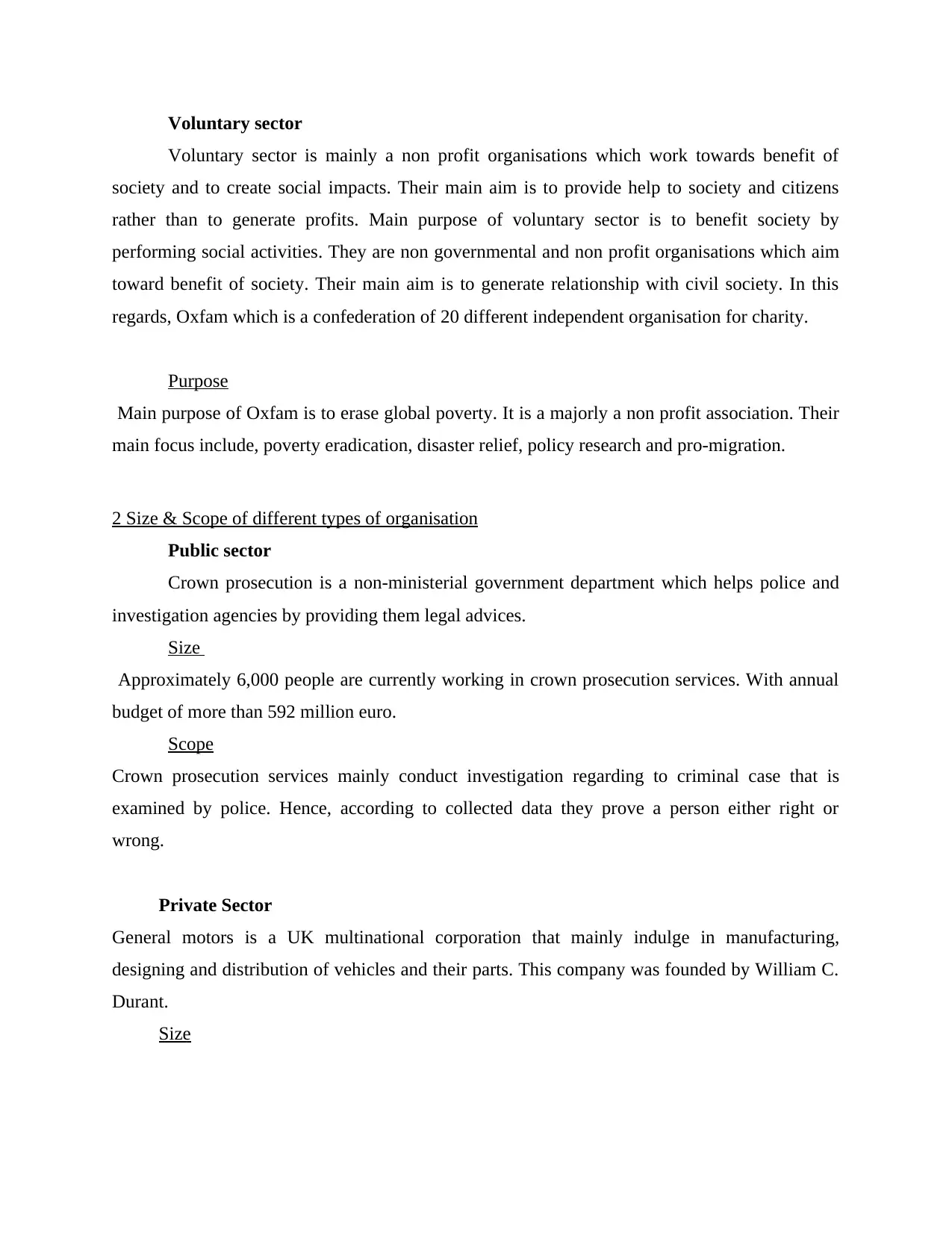
Voluntary sector
Voluntary sector is mainly a non profit organisations which work towards benefit of
society and to create social impacts. Their main aim is to provide help to society and citizens
rather than to generate profits. Main purpose of voluntary sector is to benefit society by
performing social activities. They are non governmental and non profit organisations which aim
toward benefit of society. Their main aim is to generate relationship with civil society. In this
regards, Oxfam which is a confederation of 20 different independent organisation for charity.
Purpose
Main purpose of Oxfam is to erase global poverty. It is a majorly a non profit association. Their
main focus include, poverty eradication, disaster relief, policy research and pro-migration.
2 Size & Scope of different types of organisation
Public sector
Crown prosecution is a non-ministerial government department which helps police and
investigation agencies by providing them legal advices.
Size
Approximately 6,000 people are currently working in crown prosecution services. With annual
budget of more than 592 million euro.
Scope
Crown prosecution services mainly conduct investigation regarding to criminal case that is
examined by police. Hence, according to collected data they prove a person either right or
wrong.
Private Sector
General motors is a UK multinational corporation that mainly indulge in manufacturing,
designing and distribution of vehicles and their parts. This company was founded by William C.
Durant.
Size
Voluntary sector is mainly a non profit organisations which work towards benefit of
society and to create social impacts. Their main aim is to provide help to society and citizens
rather than to generate profits. Main purpose of voluntary sector is to benefit society by
performing social activities. They are non governmental and non profit organisations which aim
toward benefit of society. Their main aim is to generate relationship with civil society. In this
regards, Oxfam which is a confederation of 20 different independent organisation for charity.
Purpose
Main purpose of Oxfam is to erase global poverty. It is a majorly a non profit association. Their
main focus include, poverty eradication, disaster relief, policy research and pro-migration.
2 Size & Scope of different types of organisation
Public sector
Crown prosecution is a non-ministerial government department which helps police and
investigation agencies by providing them legal advices.
Size
Approximately 6,000 people are currently working in crown prosecution services. With annual
budget of more than 592 million euro.
Scope
Crown prosecution services mainly conduct investigation regarding to criminal case that is
examined by police. Hence, according to collected data they prove a person either right or
wrong.
Private Sector
General motors is a UK multinational corporation that mainly indulge in manufacturing,
designing and distribution of vehicles and their parts. This company was founded by William C.
Durant.
Size
Paraphrase This Document
Need a fresh take? Get an instant paraphrase of this document with our AI Paraphraser
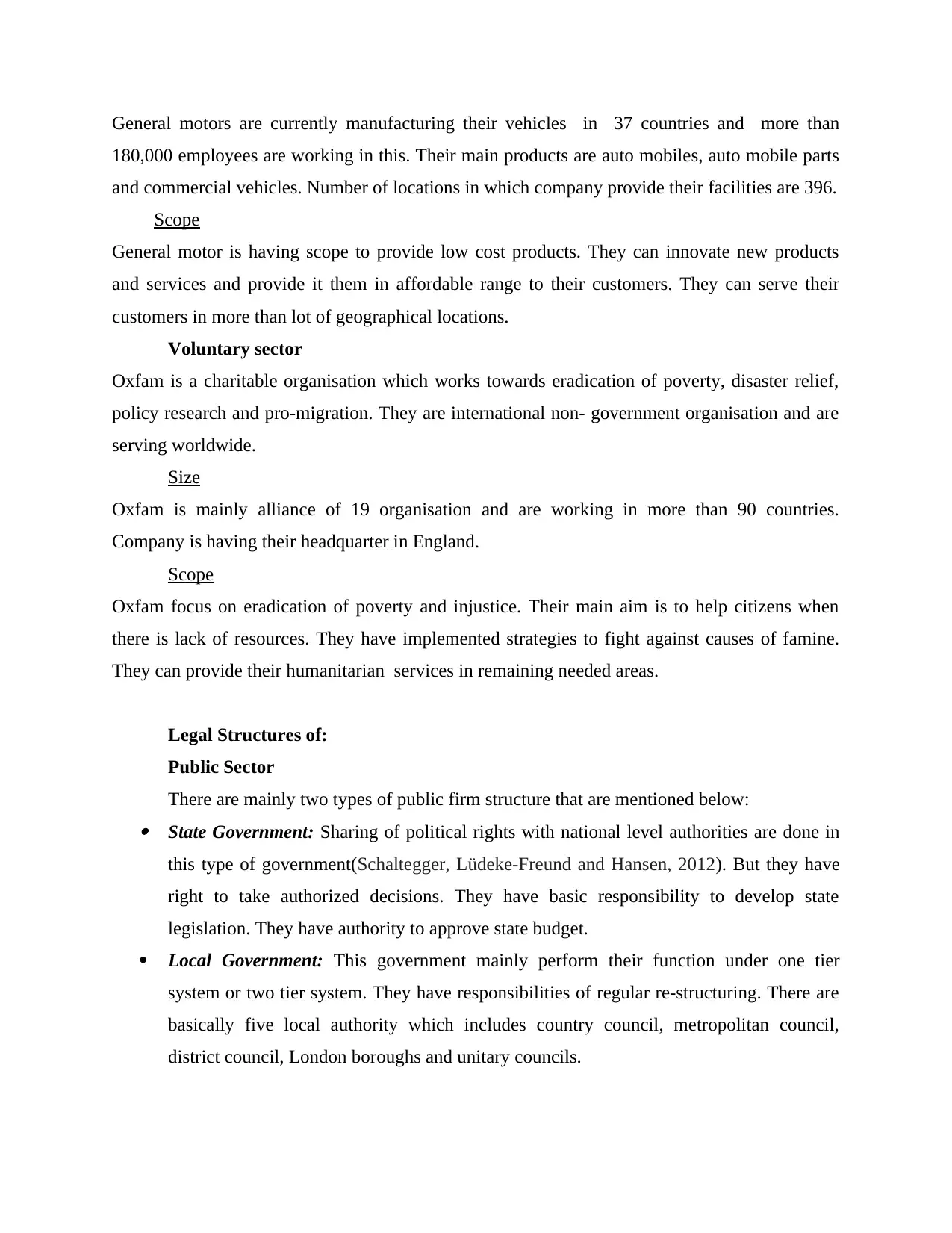
General motors are currently manufacturing their vehicles in 37 countries and more than
180,000 employees are working in this. Their main products are auto mobiles, auto mobile parts
and commercial vehicles. Number of locations in which company provide their facilities are 396.
Scope
General motor is having scope to provide low cost products. They can innovate new products
and services and provide it them in affordable range to their customers. They can serve their
customers in more than lot of geographical locations.
Voluntary sector
Oxfam is a charitable organisation which works towards eradication of poverty, disaster relief,
policy research and pro-migration. They are international non- government organisation and are
serving worldwide.
Size
Oxfam is mainly alliance of 19 organisation and are working in more than 90 countries.
Company is having their headquarter in England.
Scope
Oxfam focus on eradication of poverty and injustice. Their main aim is to help citizens when
there is lack of resources. They have implemented strategies to fight against causes of famine.
They can provide their humanitarian services in remaining needed areas.
Legal Structures of:
Public Sector
There are mainly two types of public firm structure that are mentioned below: State Government: Sharing of political rights with national level authorities are done in
this type of government(Schaltegger, Lüdeke-Freund and Hansen, 2012). But they have
right to take authorized decisions. They have basic responsibility to develop state
legislation. They have authority to approve state budget.
Local Government: This government mainly perform their function under one tier
system or two tier system. They have responsibilities of regular re-structuring. There are
basically five local authority which includes country council, metropolitan council,
district council, London boroughs and unitary councils.
180,000 employees are working in this. Their main products are auto mobiles, auto mobile parts
and commercial vehicles. Number of locations in which company provide their facilities are 396.
Scope
General motor is having scope to provide low cost products. They can innovate new products
and services and provide it them in affordable range to their customers. They can serve their
customers in more than lot of geographical locations.
Voluntary sector
Oxfam is a charitable organisation which works towards eradication of poverty, disaster relief,
policy research and pro-migration. They are international non- government organisation and are
serving worldwide.
Size
Oxfam is mainly alliance of 19 organisation and are working in more than 90 countries.
Company is having their headquarter in England.
Scope
Oxfam focus on eradication of poverty and injustice. Their main aim is to help citizens when
there is lack of resources. They have implemented strategies to fight against causes of famine.
They can provide their humanitarian services in remaining needed areas.
Legal Structures of:
Public Sector
There are mainly two types of public firm structure that are mentioned below: State Government: Sharing of political rights with national level authorities are done in
this type of government(Schaltegger, Lüdeke-Freund and Hansen, 2012). But they have
right to take authorized decisions. They have basic responsibility to develop state
legislation. They have authority to approve state budget.
Local Government: This government mainly perform their function under one tier
system or two tier system. They have responsibilities of regular re-structuring. There are
basically five local authority which includes country council, metropolitan council,
district council, London boroughs and unitary councils.

Central Government: Central government is supreme and highest governing authority
in a unitary state. They create new rules and policies which is require by other governing
bodies to function.
Private Sector
Private firms follow two types of structure that are described below: Sole proprietorship: It is one of the most simplest form of business which is owned and
controlled by single person. Sole trader, individual entrepreneurship is another name of
this form of structure(Ballard, and et.al., 2012). Sole trader is responsible for all debts
and profits. Book keeping, home healthcare, financial planners, computer repair-services,
catering company, freelancer writer are some examples of sole proprietor ship. Sole
proprietor can perform their work as an independent business operator. They have
responsible to pay tax specific to their business and are fully responsible for debts and
losses.
Partnership: In this type of private sector, there is an agreement between two or more
than two public or private sectors. All roles and responsibility are mentioned in a
partnership deep which is duly signed by partners(Werbach, K. and Hunter, D., 2012).
This will benefit in taking systematic decisions and resolving issues and conflicts which
may arise in future between any partner.
Voluntary Sector
There are mainly three sectors in voluntary organisation that are:
Trust: A trust is form of Corporation which is especially known as commercial banks
because it is formulated to achieve as a guardian of agencies and trusts. Responsibility of
managing investments, assets,pay bills, medical expenses and charitable gifts are done by
trustee.
Unincorporated association: It is a non-profit association which is created when at least
two individuals give their consent on pursuing a common legal purpose. It is basically a
informal organisation in which people act together for sharing interest rather than
generating profits.
Company limited by guarantee( CLG): It is a company where there is no shareholders
but their members acts as a guarantors. In this type of sector member have to contribute a
in a unitary state. They create new rules and policies which is require by other governing
bodies to function.
Private Sector
Private firms follow two types of structure that are described below: Sole proprietorship: It is one of the most simplest form of business which is owned and
controlled by single person. Sole trader, individual entrepreneurship is another name of
this form of structure(Ballard, and et.al., 2012). Sole trader is responsible for all debts
and profits. Book keeping, home healthcare, financial planners, computer repair-services,
catering company, freelancer writer are some examples of sole proprietor ship. Sole
proprietor can perform their work as an independent business operator. They have
responsible to pay tax specific to their business and are fully responsible for debts and
losses.
Partnership: In this type of private sector, there is an agreement between two or more
than two public or private sectors. All roles and responsibility are mentioned in a
partnership deep which is duly signed by partners(Werbach, K. and Hunter, D., 2012).
This will benefit in taking systematic decisions and resolving issues and conflicts which
may arise in future between any partner.
Voluntary Sector
There are mainly three sectors in voluntary organisation that are:
Trust: A trust is form of Corporation which is especially known as commercial banks
because it is formulated to achieve as a guardian of agencies and trusts. Responsibility of
managing investments, assets,pay bills, medical expenses and charitable gifts are done by
trustee.
Unincorporated association: It is a non-profit association which is created when at least
two individuals give their consent on pursuing a common legal purpose. It is basically a
informal organisation in which people act together for sharing interest rather than
generating profits.
Company limited by guarantee( CLG): It is a company where there is no shareholders
but their members acts as a guarantors. In this type of sector member have to contribute a
⊘ This is a preview!⊘
Do you want full access?
Subscribe today to unlock all pages.

Trusted by 1+ million students worldwide
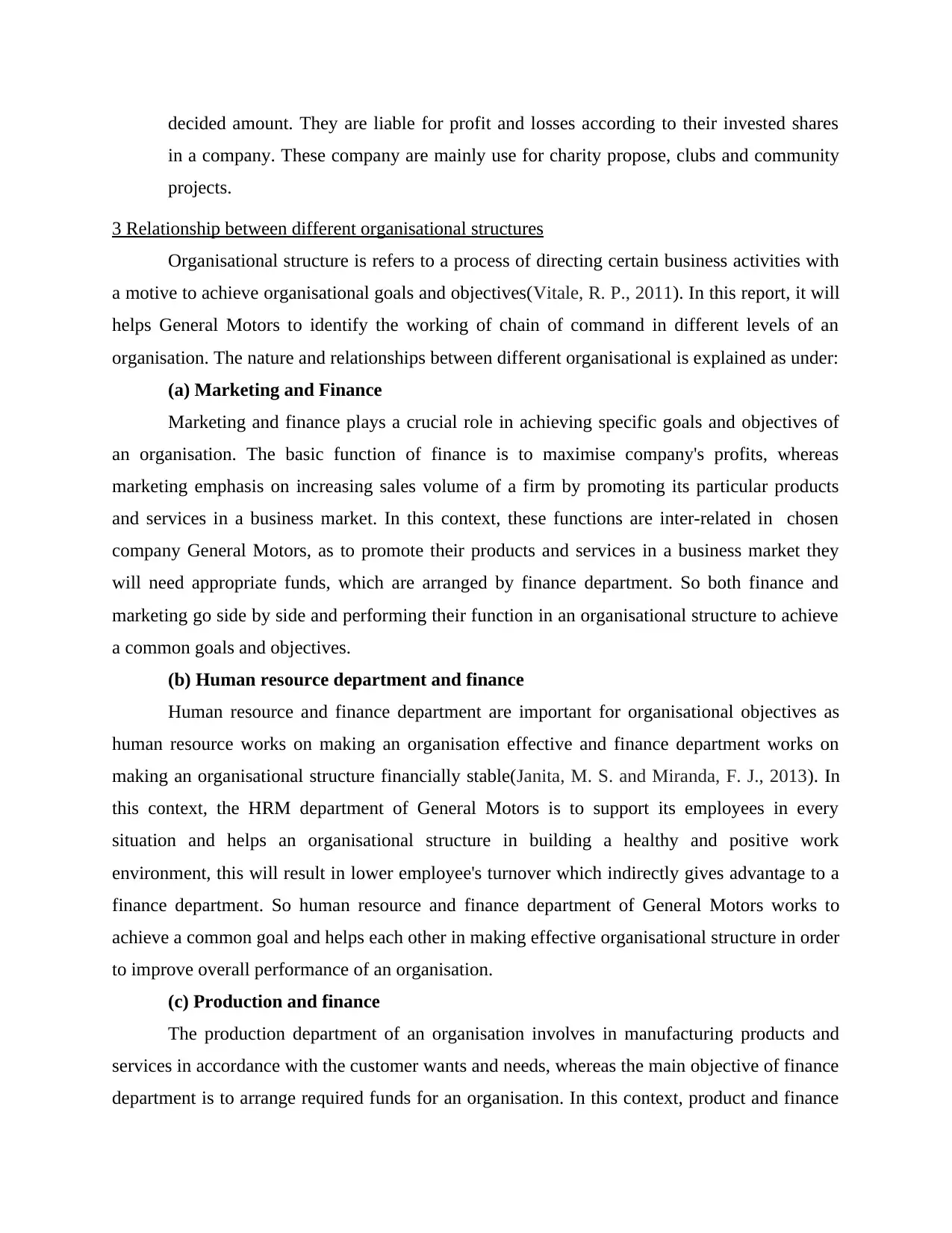
decided amount. They are liable for profit and losses according to their invested shares
in a company. These company are mainly use for charity propose, clubs and community
projects.
3 Relationship between different organisational structures
Organisational structure is refers to a process of directing certain business activities with
a motive to achieve organisational goals and objectives(Vitale, R. P., 2011). In this report, it will
helps General Motors to identify the working of chain of command in different levels of an
organisation. The nature and relationships between different organisational is explained as under:
(a) Marketing and Finance
Marketing and finance plays a crucial role in achieving specific goals and objectives of
an organisation. The basic function of finance is to maximise company's profits, whereas
marketing emphasis on increasing sales volume of a firm by promoting its particular products
and services in a business market. In this context, these functions are inter-related in chosen
company General Motors, as to promote their products and services in a business market they
will need appropriate funds, which are arranged by finance department. So both finance and
marketing go side by side and performing their function in an organisational structure to achieve
a common goals and objectives.
(b) Human resource department and finance
Human resource and finance department are important for organisational objectives as
human resource works on making an organisation effective and finance department works on
making an organisational structure financially stable(Janita, M. S. and Miranda, F. J., 2013). In
this context, the HRM department of General Motors is to support its employees in every
situation and helps an organisational structure in building a healthy and positive work
environment, this will result in lower employee's turnover which indirectly gives advantage to a
finance department. So human resource and finance department of General Motors works to
achieve a common goal and helps each other in making effective organisational structure in order
to improve overall performance of an organisation.
(c) Production and finance
The production department of an organisation involves in manufacturing products and
services in accordance with the customer wants and needs, whereas the main objective of finance
department is to arrange required funds for an organisation. In this context, product and finance
in a company. These company are mainly use for charity propose, clubs and community
projects.
3 Relationship between different organisational structures
Organisational structure is refers to a process of directing certain business activities with
a motive to achieve organisational goals and objectives(Vitale, R. P., 2011). In this report, it will
helps General Motors to identify the working of chain of command in different levels of an
organisation. The nature and relationships between different organisational is explained as under:
(a) Marketing and Finance
Marketing and finance plays a crucial role in achieving specific goals and objectives of
an organisation. The basic function of finance is to maximise company's profits, whereas
marketing emphasis on increasing sales volume of a firm by promoting its particular products
and services in a business market. In this context, these functions are inter-related in chosen
company General Motors, as to promote their products and services in a business market they
will need appropriate funds, which are arranged by finance department. So both finance and
marketing go side by side and performing their function in an organisational structure to achieve
a common goals and objectives.
(b) Human resource department and finance
Human resource and finance department are important for organisational objectives as
human resource works on making an organisation effective and finance department works on
making an organisational structure financially stable(Janita, M. S. and Miranda, F. J., 2013). In
this context, the HRM department of General Motors is to support its employees in every
situation and helps an organisational structure in building a healthy and positive work
environment, this will result in lower employee's turnover which indirectly gives advantage to a
finance department. So human resource and finance department of General Motors works to
achieve a common goal and helps each other in making effective organisational structure in order
to improve overall performance of an organisation.
(c) Production and finance
The production department of an organisation involves in manufacturing products and
services in accordance with the customer wants and needs, whereas the main objective of finance
department is to arrange required funds for an organisation. In this context, product and finance
Paraphrase This Document
Need a fresh take? Get an instant paraphrase of this document with our AI Paraphraser
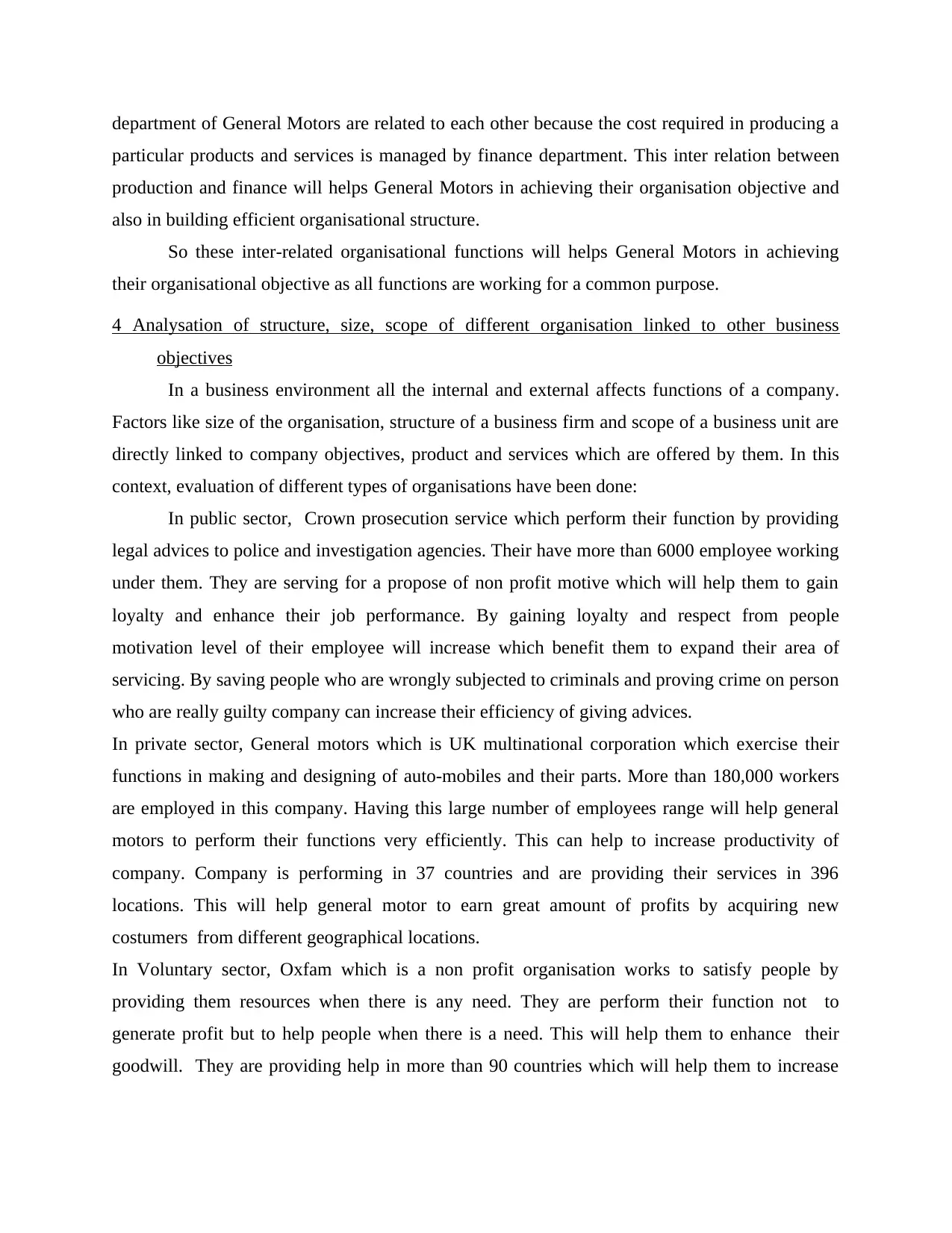
department of General Motors are related to each other because the cost required in producing a
particular products and services is managed by finance department. This inter relation between
production and finance will helps General Motors in achieving their organisation objective and
also in building efficient organisational structure.
So these inter-related organisational functions will helps General Motors in achieving
their organisational objective as all functions are working for a common purpose.
4 Analysation of structure, size, scope of different organisation linked to other business
objectives
In a business environment all the internal and external affects functions of a company.
Factors like size of the organisation, structure of a business firm and scope of a business unit are
directly linked to company objectives, product and services which are offered by them. In this
context, evaluation of different types of organisations have been done:
In public sector, Crown prosecution service which perform their function by providing
legal advices to police and investigation agencies. Their have more than 6000 employee working
under them. They are serving for a propose of non profit motive which will help them to gain
loyalty and enhance their job performance. By gaining loyalty and respect from people
motivation level of their employee will increase which benefit them to expand their area of
servicing. By saving people who are wrongly subjected to criminals and proving crime on person
who are really guilty company can increase their efficiency of giving advices.
In private sector, General motors which is UK multinational corporation which exercise their
functions in making and designing of auto-mobiles and their parts. More than 180,000 workers
are employed in this company. Having this large number of employees range will help general
motors to perform their functions very efficiently. This can help to increase productivity of
company. Company is performing in 37 countries and are providing their services in 396
locations. This will help general motor to earn great amount of profits by acquiring new
costumers from different geographical locations.
In Voluntary sector, Oxfam which is a non profit organisation works to satisfy people by
providing them resources when there is any need. They are perform their function not to
generate profit but to help people when there is a need. This will help them to enhance their
goodwill. They are providing help in more than 90 countries which will help them to increase
particular products and services is managed by finance department. This inter relation between
production and finance will helps General Motors in achieving their organisation objective and
also in building efficient organisational structure.
So these inter-related organisational functions will helps General Motors in achieving
their organisational objective as all functions are working for a common purpose.
4 Analysation of structure, size, scope of different organisation linked to other business
objectives
In a business environment all the internal and external affects functions of a company.
Factors like size of the organisation, structure of a business firm and scope of a business unit are
directly linked to company objectives, product and services which are offered by them. In this
context, evaluation of different types of organisations have been done:
In public sector, Crown prosecution service which perform their function by providing
legal advices to police and investigation agencies. Their have more than 6000 employee working
under them. They are serving for a propose of non profit motive which will help them to gain
loyalty and enhance their job performance. By gaining loyalty and respect from people
motivation level of their employee will increase which benefit them to expand their area of
servicing. By saving people who are wrongly subjected to criminals and proving crime on person
who are really guilty company can increase their efficiency of giving advices.
In private sector, General motors which is UK multinational corporation which exercise their
functions in making and designing of auto-mobiles and their parts. More than 180,000 workers
are employed in this company. Having this large number of employees range will help general
motors to perform their functions very efficiently. This can help to increase productivity of
company. Company is performing in 37 countries and are providing their services in 396
locations. This will help general motor to earn great amount of profits by acquiring new
costumers from different geographical locations.
In Voluntary sector, Oxfam which is a non profit organisation works to satisfy people by
providing them resources when there is any need. They are perform their function not to
generate profit but to help people when there is a need. This will help them to enhance their
goodwill. They are providing help in more than 90 countries which will help them to increase

their area of service and will generate feeling of humanity in their volunteers and they will work
with more motivation. This will benefit company to enhance their performance level.
5 Critical analysis of different types of business structures and inter-relation of different
organisational function
A business structure comprises of various department which works together to achieve
common goals and objectives(Wheelen, T. L. and et.al., 2017). There are three types of
organisational structure in a business market .i.e. public, private and voluntary. The critical
analysis of business structure follows by chosen organisations are:
(a) Public Sector
A public company is owned, managed and controlled by government with a motive to
provide benefits to individual and society. In this context, the chosen public sector company is
Crown Prosecution Services follows corporate governance structure which is supported by audit
committee and government executives. In this structure rights and responsibilities are distributed
among various stakeholders and participants of the organisation, which leads in achieving their
societal objectives and monitoring performance. There are various complexities for the company
having corporate governance structure which are:
1. Ownership and management Separation
In this context, the chosen organisation Crown Prosecution Services is controlled by
board of directors and the officers in which there is no role of its shareholders, which can leads
to create conflicts in a business entity. It will makes an organisation to suffer in terms of its
market value as there is separation of management and ownership.
2. Misleading financial statement
As the chosen organisation Crown Prosecution Services is managing its business
activities, which sometimes leads in presenting financial facts and information in in an
unappropriated manner that can misleads its investors. It will cause a harm on company's
revenue in a business environment.
(b) Private Sector:
A private company is run by individual with an intention to generate profits. In this
context, the chosen private sector company is General Motors which follows flat organisational
with more motivation. This will benefit company to enhance their performance level.
5 Critical analysis of different types of business structures and inter-relation of different
organisational function
A business structure comprises of various department which works together to achieve
common goals and objectives(Wheelen, T. L. and et.al., 2017). There are three types of
organisational structure in a business market .i.e. public, private and voluntary. The critical
analysis of business structure follows by chosen organisations are:
(a) Public Sector
A public company is owned, managed and controlled by government with a motive to
provide benefits to individual and society. In this context, the chosen public sector company is
Crown Prosecution Services follows corporate governance structure which is supported by audit
committee and government executives. In this structure rights and responsibilities are distributed
among various stakeholders and participants of the organisation, which leads in achieving their
societal objectives and monitoring performance. There are various complexities for the company
having corporate governance structure which are:
1. Ownership and management Separation
In this context, the chosen organisation Crown Prosecution Services is controlled by
board of directors and the officers in which there is no role of its shareholders, which can leads
to create conflicts in a business entity. It will makes an organisation to suffer in terms of its
market value as there is separation of management and ownership.
2. Misleading financial statement
As the chosen organisation Crown Prosecution Services is managing its business
activities, which sometimes leads in presenting financial facts and information in in an
unappropriated manner that can misleads its investors. It will cause a harm on company's
revenue in a business environment.
(b) Private Sector:
A private company is run by individual with an intention to generate profits. In this
context, the chosen private sector company is General Motors which follows flat organisational
⊘ This is a preview!⊘
Do you want full access?
Subscribe today to unlock all pages.

Trusted by 1+ million students worldwide

structure. In this structure there are few or no individuals between management and staff
members. The complexities of having flat organisational structure is explained below:
1. Limit productivity
In regard to General Motors, as they are following flat organisational structure there will
be no close supervision on a particular task because there are less number of individuals, so it
will simultaneously limits their productivity as compared to their competitors.
2. Bad decision-making
This structure will cause bad decision making situation in General Motors because they
relies majorly on the expertise of their front line staff. It will cause to decrease in their
performance level in a business environment.
(c) Voluntary sector
A voluntary sector company is mainly a non profit organisation, which gives more
emphasis on achieving objectives related to society. In this context, the chosen voluntary sector
organisation is Oxfam, which follows flat organisational structure. The complexities of having
flat organisational structure is explained below:
1. Wastage of time
In this context, it is time consuming for the chosen organisation General Motors as they
are limited number of individual in the management process, so it takes time in ensuring that the
idea is duplicated or not.
2. Not scalable
This organisational structure is only suitable for small organisation but General Motors is
established at a global level, so there will be a difficulty in measuring overall growth of an
organisation.
Inter-relation functions play an important role in every organisation whether it is public,
private or social (Ullah, A. and Lai, R., 2011). In this context, there are many departments in
General Motors which are inter-related with each other, as they are working together to achieve a
common purpose. For instance, finance department of General motors is helping its Marketing
department by generating funds for their promotion and advertising expenses.
Advantages and disadvantages of interrelationships between functions
Advantages –
members. The complexities of having flat organisational structure is explained below:
1. Limit productivity
In regard to General Motors, as they are following flat organisational structure there will
be no close supervision on a particular task because there are less number of individuals, so it
will simultaneously limits their productivity as compared to their competitors.
2. Bad decision-making
This structure will cause bad decision making situation in General Motors because they
relies majorly on the expertise of their front line staff. It will cause to decrease in their
performance level in a business environment.
(c) Voluntary sector
A voluntary sector company is mainly a non profit organisation, which gives more
emphasis on achieving objectives related to society. In this context, the chosen voluntary sector
organisation is Oxfam, which follows flat organisational structure. The complexities of having
flat organisational structure is explained below:
1. Wastage of time
In this context, it is time consuming for the chosen organisation General Motors as they
are limited number of individual in the management process, so it takes time in ensuring that the
idea is duplicated or not.
2. Not scalable
This organisational structure is only suitable for small organisation but General Motors is
established at a global level, so there will be a difficulty in measuring overall growth of an
organisation.
Inter-relation functions play an important role in every organisation whether it is public,
private or social (Ullah, A. and Lai, R., 2011). In this context, there are many departments in
General Motors which are inter-related with each other, as they are working together to achieve a
common purpose. For instance, finance department of General motors is helping its Marketing
department by generating funds for their promotion and advertising expenses.
Advantages and disadvantages of interrelationships between functions
Advantages –
Paraphrase This Document
Need a fresh take? Get an instant paraphrase of this document with our AI Paraphraser
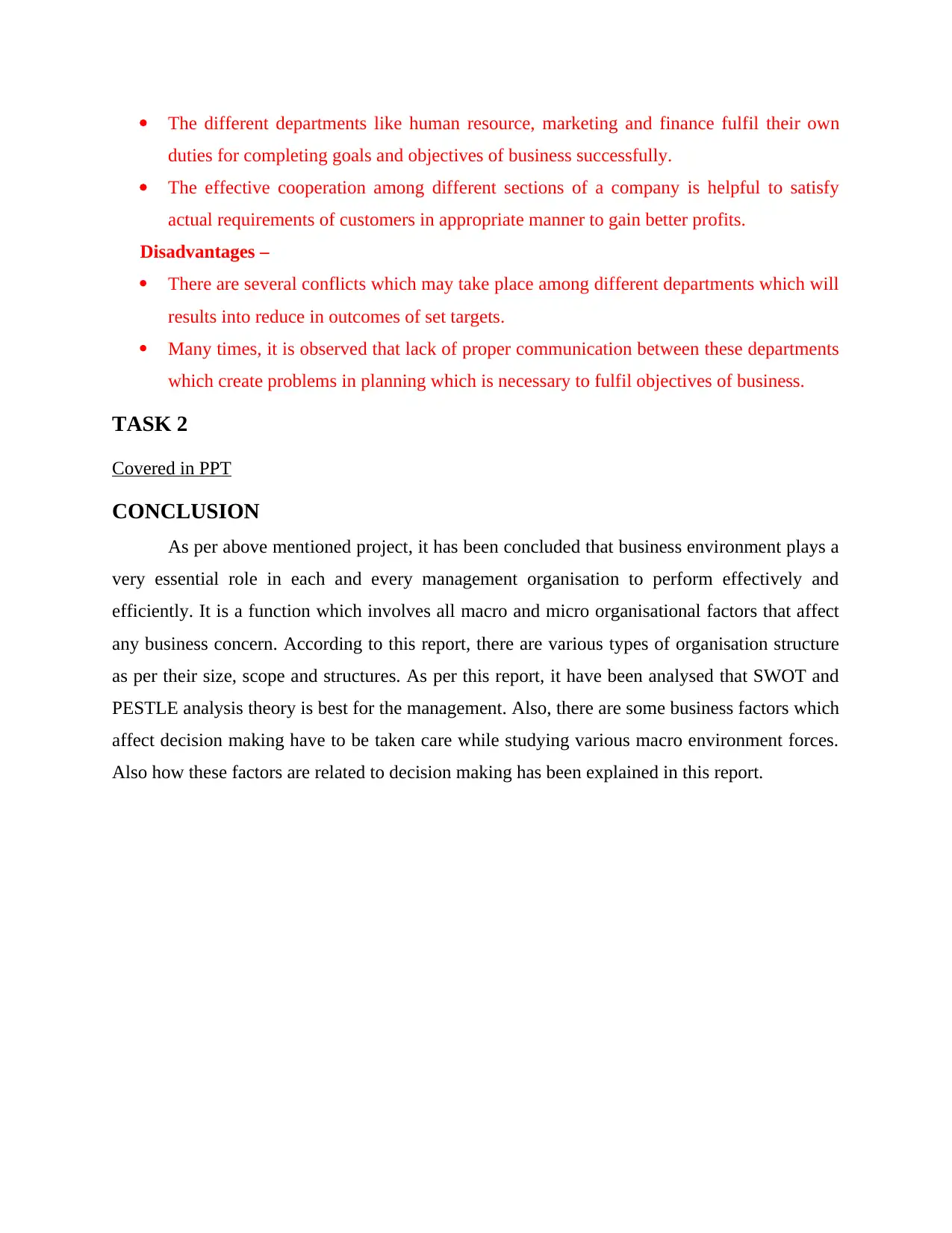
The different departments like human resource, marketing and finance fulfil their own
duties for completing goals and objectives of business successfully.
The effective cooperation among different sections of a company is helpful to satisfy
actual requirements of customers in appropriate manner to gain better profits.
Disadvantages –
There are several conflicts which may take place among different departments which will
results into reduce in outcomes of set targets.
Many times, it is observed that lack of proper communication between these departments
which create problems in planning which is necessary to fulfil objectives of business.
TASK 2
Covered in PPT
CONCLUSION
As per above mentioned project, it has been concluded that business environment plays a
very essential role in each and every management organisation to perform effectively and
efficiently. It is a function which involves all macro and micro organisational factors that affect
any business concern. According to this report, there are various types of organisation structure
as per their size, scope and structures. As per this report, it have been analysed that SWOT and
PESTLE analysis theory is best for the management. Also, there are some business factors which
affect decision making have to be taken care while studying various macro environment forces.
Also how these factors are related to decision making has been explained in this report.
duties for completing goals and objectives of business successfully.
The effective cooperation among different sections of a company is helpful to satisfy
actual requirements of customers in appropriate manner to gain better profits.
Disadvantages –
There are several conflicts which may take place among different departments which will
results into reduce in outcomes of set targets.
Many times, it is observed that lack of proper communication between these departments
which create problems in planning which is necessary to fulfil objectives of business.
TASK 2
Covered in PPT
CONCLUSION
As per above mentioned project, it has been concluded that business environment plays a
very essential role in each and every management organisation to perform effectively and
efficiently. It is a function which involves all macro and micro organisational factors that affect
any business concern. According to this report, there are various types of organisation structure
as per their size, scope and structures. As per this report, it have been analysed that SWOT and
PESTLE analysis theory is best for the management. Also, there are some business factors which
affect decision making have to be taken care while studying various macro environment forces.
Also how these factors are related to decision making has been explained in this report.
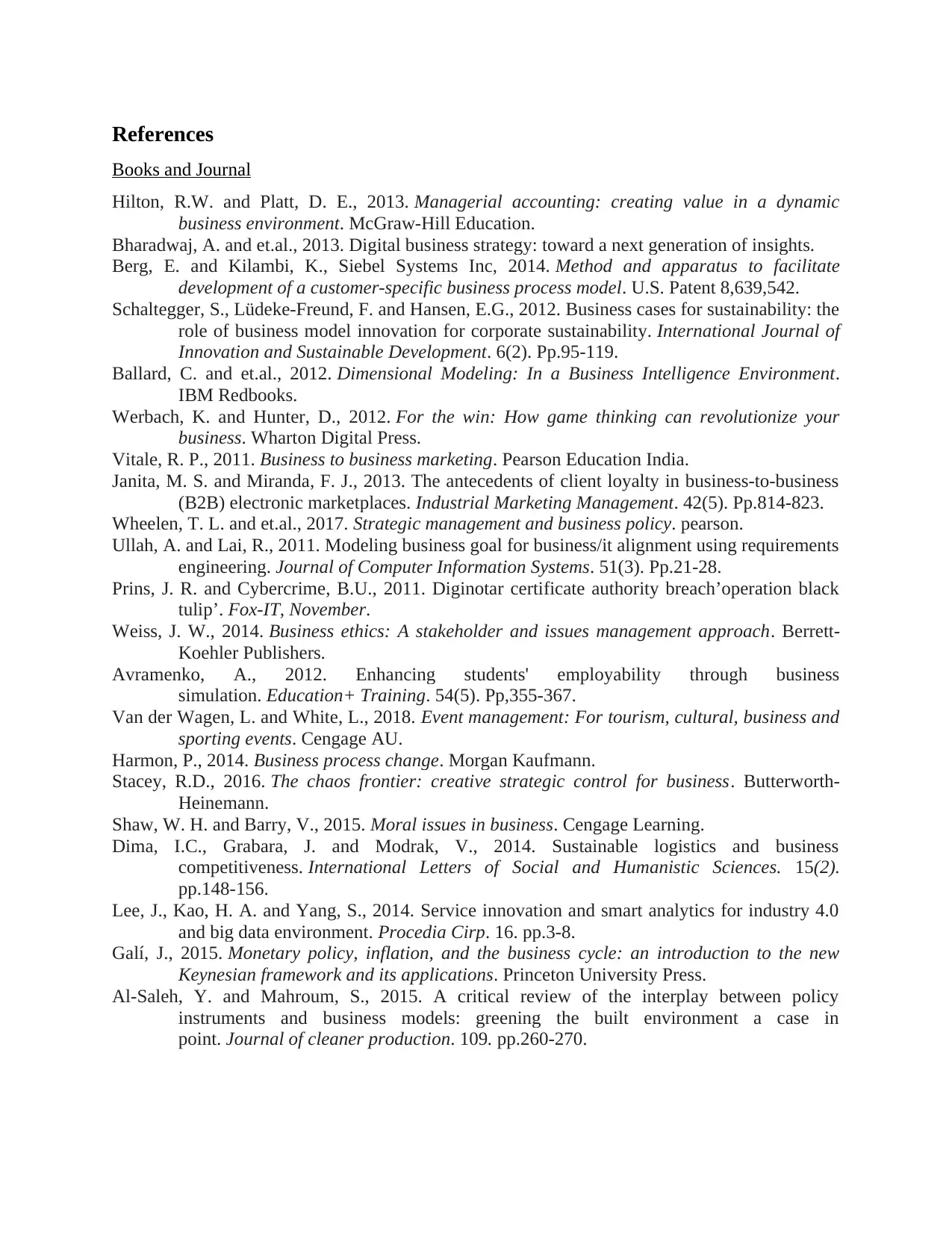
References
Books and Journal
Hilton, R.W. and Platt, D. E., 2013. Managerial accounting: creating value in a dynamic
business environment. McGraw-Hill Education.
Bharadwaj, A. and et.al., 2013. Digital business strategy: toward a next generation of insights.
Berg, E. and Kilambi, K., Siebel Systems Inc, 2014. Method and apparatus to facilitate
development of a customer-specific business process model. U.S. Patent 8,639,542.
Schaltegger, S., Lüdeke-Freund, F. and Hansen, E.G., 2012. Business cases for sustainability: the
role of business model innovation for corporate sustainability. International Journal of
Innovation and Sustainable Development. 6(2). Pp.95-119.
Ballard, C. and et.al., 2012. Dimensional Modeling: In a Business Intelligence Environment.
IBM Redbooks.
Werbach, K. and Hunter, D., 2012. For the win: How game thinking can revolutionize your
business. Wharton Digital Press.
Vitale, R. P., 2011. Business to business marketing. Pearson Education India.
Janita, M. S. and Miranda, F. J., 2013. The antecedents of client loyalty in business-to-business
(B2B) electronic marketplaces. Industrial Marketing Management. 42(5). Pp.814-823.
Wheelen, T. L. and et.al., 2017. Strategic management and business policy. pearson.
Ullah, A. and Lai, R., 2011. Modeling business goal for business/it alignment using requirements
engineering. Journal of Computer Information Systems. 51(3). Pp.21-28.
Prins, J. R. and Cybercrime, B.U., 2011. Diginotar certificate authority breach’operation black
tulip’. Fox-IT, November.
Weiss, J. W., 2014. Business ethics: A stakeholder and issues management approach. Berrett-
Koehler Publishers.
Avramenko, A., 2012. Enhancing students' employability through business
simulation. Education+ Training. 54(5). Pp,355-367.
Van der Wagen, L. and White, L., 2018. Event management: For tourism, cultural, business and
sporting events. Cengage AU.
Harmon, P., 2014. Business process change. Morgan Kaufmann.
Stacey, R.D., 2016. The chaos frontier: creative strategic control for business. Butterworth-
Heinemann.
Shaw, W. H. and Barry, V., 2015. Moral issues in business. Cengage Learning.
Dima, I.C., Grabara, J. and Modrak, V., 2014. Sustainable logistics and business
competitiveness. International Letters of Social and Humanistic Sciences. 15(2).
pp.148-156.
Lee, J., Kao, H. A. and Yang, S., 2014. Service innovation and smart analytics for industry 4.0
and big data environment. Procedia Cirp. 16. pp.3-8.
Galí, J., 2015. Monetary policy, inflation, and the business cycle: an introduction to the new
Keynesian framework and its applications. Princeton University Press.
Al-Saleh, Y. and Mahroum, S., 2015. A critical review of the interplay between policy
instruments and business models: greening the built environment a case in
point. Journal of cleaner production. 109. pp.260-270.
Books and Journal
Hilton, R.W. and Platt, D. E., 2013. Managerial accounting: creating value in a dynamic
business environment. McGraw-Hill Education.
Bharadwaj, A. and et.al., 2013. Digital business strategy: toward a next generation of insights.
Berg, E. and Kilambi, K., Siebel Systems Inc, 2014. Method and apparatus to facilitate
development of a customer-specific business process model. U.S. Patent 8,639,542.
Schaltegger, S., Lüdeke-Freund, F. and Hansen, E.G., 2012. Business cases for sustainability: the
role of business model innovation for corporate sustainability. International Journal of
Innovation and Sustainable Development. 6(2). Pp.95-119.
Ballard, C. and et.al., 2012. Dimensional Modeling: In a Business Intelligence Environment.
IBM Redbooks.
Werbach, K. and Hunter, D., 2012. For the win: How game thinking can revolutionize your
business. Wharton Digital Press.
Vitale, R. P., 2011. Business to business marketing. Pearson Education India.
Janita, M. S. and Miranda, F. J., 2013. The antecedents of client loyalty in business-to-business
(B2B) electronic marketplaces. Industrial Marketing Management. 42(5). Pp.814-823.
Wheelen, T. L. and et.al., 2017. Strategic management and business policy. pearson.
Ullah, A. and Lai, R., 2011. Modeling business goal for business/it alignment using requirements
engineering. Journal of Computer Information Systems. 51(3). Pp.21-28.
Prins, J. R. and Cybercrime, B.U., 2011. Diginotar certificate authority breach’operation black
tulip’. Fox-IT, November.
Weiss, J. W., 2014. Business ethics: A stakeholder and issues management approach. Berrett-
Koehler Publishers.
Avramenko, A., 2012. Enhancing students' employability through business
simulation. Education+ Training. 54(5). Pp,355-367.
Van der Wagen, L. and White, L., 2018. Event management: For tourism, cultural, business and
sporting events. Cengage AU.
Harmon, P., 2014. Business process change. Morgan Kaufmann.
Stacey, R.D., 2016. The chaos frontier: creative strategic control for business. Butterworth-
Heinemann.
Shaw, W. H. and Barry, V., 2015. Moral issues in business. Cengage Learning.
Dima, I.C., Grabara, J. and Modrak, V., 2014. Sustainable logistics and business
competitiveness. International Letters of Social and Humanistic Sciences. 15(2).
pp.148-156.
Lee, J., Kao, H. A. and Yang, S., 2014. Service innovation and smart analytics for industry 4.0
and big data environment. Procedia Cirp. 16. pp.3-8.
Galí, J., 2015. Monetary policy, inflation, and the business cycle: an introduction to the new
Keynesian framework and its applications. Princeton University Press.
Al-Saleh, Y. and Mahroum, S., 2015. A critical review of the interplay between policy
instruments and business models: greening the built environment a case in
point. Journal of cleaner production. 109. pp.260-270.
⊘ This is a preview!⊘
Do you want full access?
Subscribe today to unlock all pages.

Trusted by 1+ million students worldwide
1 out of 13
Related Documents
Your All-in-One AI-Powered Toolkit for Academic Success.
+13062052269
info@desklib.com
Available 24*7 on WhatsApp / Email
![[object Object]](/_next/static/media/star-bottom.7253800d.svg)
Unlock your academic potential
Copyright © 2020–2025 A2Z Services. All Rights Reserved. Developed and managed by ZUCOL.




